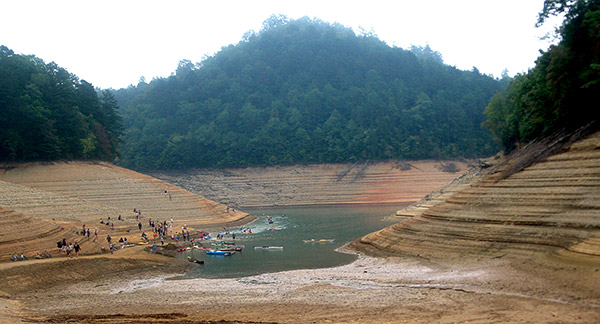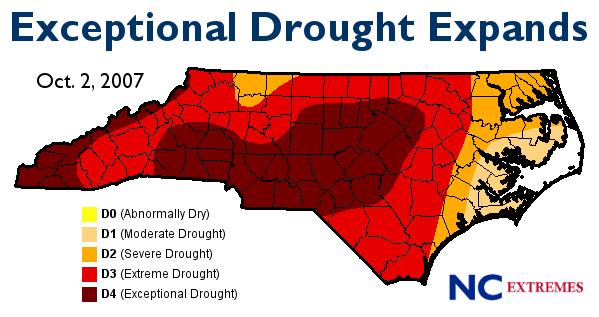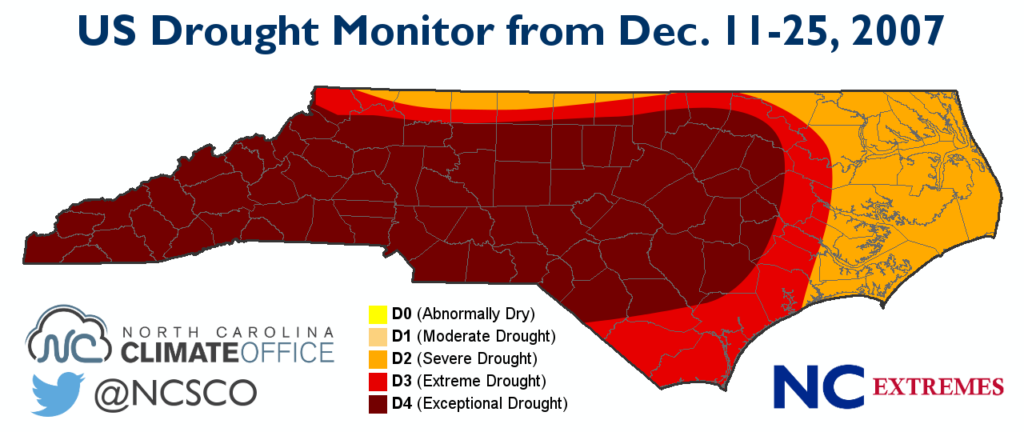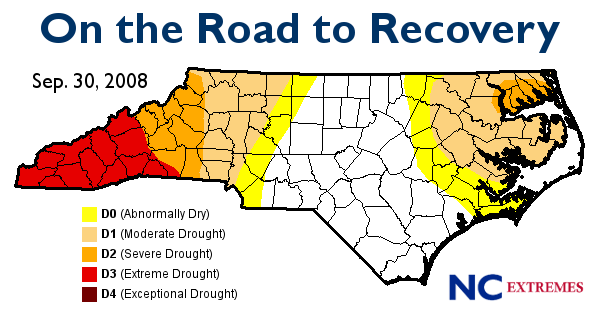This post is part of our year-long series about North Carolina’s weather extremes.
In some of the extreme weather events we’ve covered this year, there were dramatic impacts like an 18-foot storm surge or a line of damaging tornadoes. Other events had a clear peak, like when morning lows dropped below zero on “the Coldest Day” or highs topped 100°F on our hottest afternoons.
Drought is a bit different. There are no Hollywood-style scenes of disastrous storms or even a clear beginning, middle, and ending. And in some ways, that makes severe droughts all the more insidious as they linger and their impacts worsen.
We don’t have to go far back in time to find North Carolina’s worst drought. Chances are that you probably lived through it and the hot, dry weather and water restrictions that accompanied it. Here’s the story of the drought of 2007 and 2008.

The Onset of Drought
When 2007 began, drought was hardly a concern in North Carolina. The previous fall was the 4th-wettest on record and the El Niño in place promised a wet winter.

While January was slightly wetter than normal, it was followed by warm, dry weather in February and March. By mid-March, the US Drought Monitor classified much of the state in Abnormally Dry conditions, noting that farmers were able to plant early thanks to the warm weather but were facing low soil moisture levels.
Early April brought a major setback for those farmers in the form of the Easter weekend freeze. Although the sustained freezing temperatures were damaging to crops, the cool weather and a round of rainfall that followed helped alleviate the dry conditions across much of the state.
But that relief was only temporary, and the ongoing dry spring — the 10th-driest since 1895 — helped Moderate Drought conditions emerge by late May. At this point, several municipalities across the southern Piedmont began implementing water restrictions.
Summer’s Sizzle Worsens Conditions
Early in the summer, dry weather continued but near-normal temperatures largely prevented the expansion or intensification of drought conditions. However, even the Moderate Drought presented challenges for farmers, as soils dried out, crops that survived the Easter freeze withered, and some new crops failed to germinate.
By mid-June, 17 mountain counties were requested by the governor to stop all non-essential water use as a dry summer began and Extreme Drought (D3) conditions appeared in far western North Carolina. By early August, 39 public water systems were imposing restrictions, and the worst conditions were yet to come.
The first half of August brought the hottest weather of the summer as temperatures stayed in the upper 90s and low 100s for more than a week thanks to a slow-moving high pressure system to our west.

August 2007 finished as the 2nd-warmest and 2nd-driest on record, and by the beginning of September, more than 60% of the state was classified in Extreme Drought conditions.
Significant impacts also began to emerge by the end of summer, which was the 4th-driest on record. Reservoirs were depleted by the incredible demand and saw little recharge from precipitation, so many cities and counties introduced mandatory water restrictions.
Plants suffered from browning leaves and poor yield, farmers ran low on hay, and lawn watering was limited or banned in many locations. The dry conditions also allowed fires to burn. In August, 597 wildfires — nearly three times the normal number — were reported in North Carolina.
Falling Further into Drought
Although the worst of the summer heat was past, conditions didn’t improve in the fall. A persistent upper-level ridge over the eastern US meant warm and dry weather continued. Even Tropical Storm Gabrielle, which brushed the coast in September, provided little widespread relief.

The result was a still-worsening drought across the state that quickly became one of the worst on record. By early October, 37% of North Carolina was classified in D4 (Exceptional Drought) conditions — the highest category on the US Drought Monitor’s spectrum. That surpassed the maximum extent from the summer 2002 drought.
Based on other statistical drought measures, the 2007 drought rivaled or exceeded the drought of 1925, which had long been viewed as the worst ever in North Carolina.
After almost a month of bone-dry weather, several inches of rain in the final week of October helped the Exceptional Drought conditions to abate. However, the precipitation forecast wasn’t promising as La Niña conditions had emerged in the Pacific, threatening drier weather in the coming months.
Getting Worse…
Those fears were realized in November, when the state averaged less than an inch of total rainfall. Drought conditions expanded once again and water supplies began to run dangerously low. In December, 14 water systems had less than 100-day supplies remaining, including Durham, which had just 38 days worth of water in its reservoir.
Bottled water was distributed where wells dried up. Rocky Mount extended a pipeline to nearby Wilson to provide enough water for its residents. And at one point, 79% of water customers across the state — more than 5 million people — faced restrictions including outright bans on outdoor water use for homes and businesses.
The drought peaked during December, when almost two-thirds of the state was classified in Exceptional Drought for three consecutive weeks. Even several inches of rain in the final week of the month barely made a dent in the extent or intensity of the drought conditions.
By the end of 2007, the drought cost North Carolina’s agriculture industry an estimated $573 million in damage, including $130 million to soybean farmers alone.

… Then Getting Better
The dry winter persisted, ranking as the 43rd-driest and 14th-warmest out of 121 years. However, regular rainfall by March alleviated the worst of the drought conditions across the Piedmont, and a wet April meant more improvements.

By the fall of 2008, half of the state was out of drought conditions altogether, and while the southern mountains stayed dry through the following winter, the drought finally ended by the late spring of 2009, two years after it began.
Although 2007 was an exceptional year with Exceptional Drought, in many ways it exemplified the classic emergence of drought conditions in North Carolina. A month or two with little rainfall saw drought creep into one corner of the state, but its reach expanded after a dry summer.
The 2015 drought was similar, although ultimately not as severe or long-lived. After a wet April, warm and dry weather in May and June helped drought emerge in the southwestern Piedmont. Moderate Drought conditions eventually expanded across more than 40% of the state before the heavy rains of late September and early October ended the dry spell.
For this year’s drought and others we may face, the 2007 event serves as a reminder of the sometimes relentless nature of drought and the far-reaching impacts that it can have.